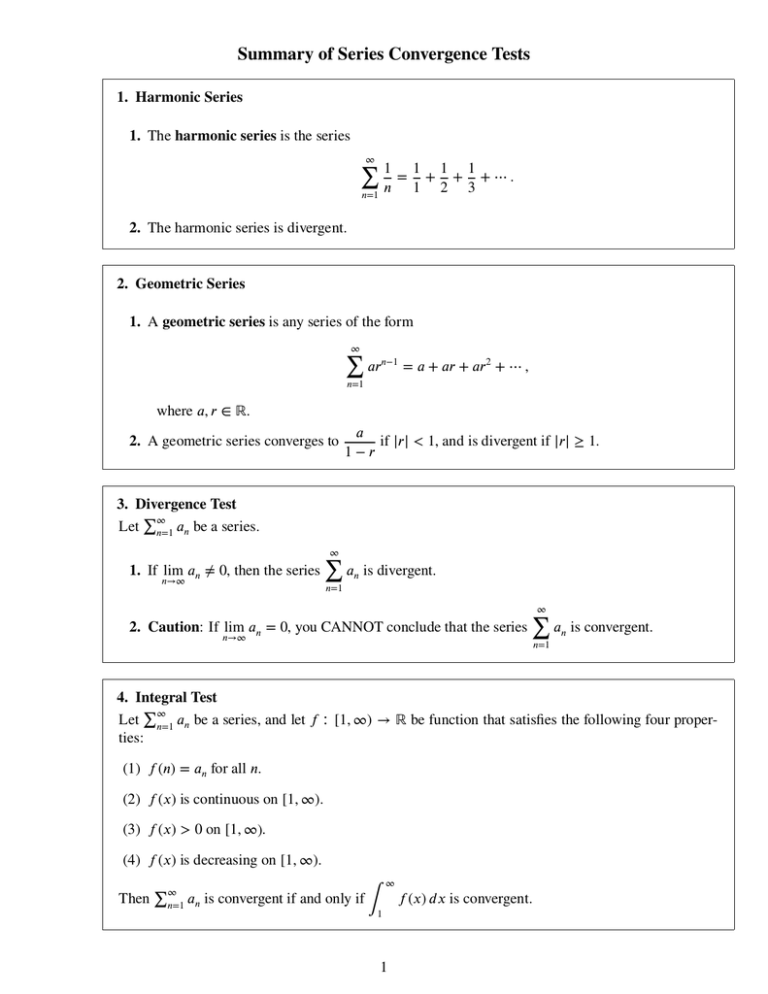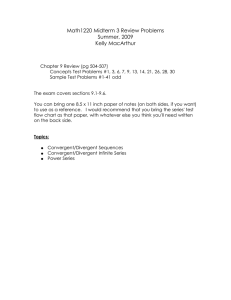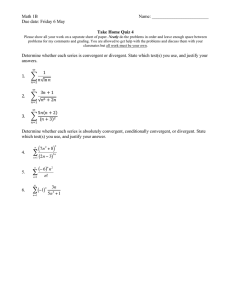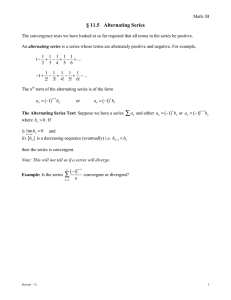Summary of Series Convergence Tests
advertisement

Summary of Series Convergence Tests
1. Harmonic Series
1. The harmonic series is the series
∞
∑
1
𝑛
𝑛=1
=
1 1 1
+ + + ⋯.
1 2 3
2. The harmonic series is divergent.
2. Geometric Series
1. A geometric series is any series of the form
∞
∑
𝑎𝑟𝑛−1 = 𝑎 + 𝑎𝑟 + 𝑎𝑟2 + ⋯ ,
𝑛=1
where 𝑎, 𝑟 ∈ ℝ.
2. A geometric series converges to
𝑎
if |𝑟| < 1, and is divergent if |𝑟| ≥ 1.
1−𝑟
3. Divergence Test
∑∞
Let 𝑛=1 𝑎𝑛 be a series.
1. If lim 𝑎𝑛 ≠ 0, then the series
𝑛→∞
∞
∑
𝑎𝑛 is divergent.
𝑛=1
2. Caution: If lim 𝑎𝑛 = 0, you CANNOT conclude that the series
∞
∑
𝑛→∞
𝑎𝑛 is convergent.
𝑛=1
4. Integral Test
∑∞
Let 𝑛=1 𝑎𝑛 be a series, and let 𝑓 ∶ [1, ∞) → ℝ be function that satisfies the following four properties:
(1) 𝑓 (𝑛) = 𝑎𝑛 for all 𝑛.
(2) 𝑓 (𝑥) is continuous on [1, ∞).
(3) 𝑓 (𝑥) > 0 on [1, ∞).
(4) 𝑓 (𝑥) is decreasing on [1, ∞).
Then
∑∞
𝑛=1
∞
𝑎𝑛 is convergent if and only if
∫1
1
𝑓 (𝑥) 𝑑𝑥 is convergent.
5. Remainder Estimate for the Integral Test
∑∞
Let 𝑛=1 𝑎𝑛 be a series.
∑∞
1. Suppose that 𝑛=1 𝑎𝑛 is convergent by the Integral Test. Let 𝑚 ∈ ℕ.
𝑚
∑
∞
𝑎𝑖 +
𝑖=1
∫𝑚+1
𝑓 (𝑥) 𝑑𝑥 ≤
∞
∑
𝑛=1
𝑎𝑛 ≤
𝑚
∑
∞
𝑎𝑖 +
𝑖=1
∫𝑚
𝑓 (𝑥) 𝑑𝑥.
2. An approximate value for the sum of the series is the average of the upper bound and the lower
bound in the above inequalities. The difference between this approximate value and the actual
sum of the series is at most half the distance between the upper bound and the lower bound.
6. 𝑝-Series
1. A 𝑝-series is any series of the form
∞
∑
1
1
1
1
= 𝑝 + 𝑝 + 𝑝 + ⋯,
𝑝
𝑛
1
2
3
𝑛=1
where 𝑝 ∈ ℝ.
2. A 𝑝-series is convergent if 𝑝 > 1, and is divergent if 𝑝 ≤ 1.
7. Comparison Test
∑∞
∑∞
Let 𝑛=1 𝑎𝑛 and 𝑛=1 𝑏𝑛 be series. Suppose that 𝑎𝑛 ≥ 0 and 𝑏𝑛 ≥ 0 for all 𝑛 ∈ ℕ. Suppose that
𝑎𝑛 ≤ 𝑏𝑛 for all 𝑛 ∈ ℕ.
1. If
∞
∑
𝑏𝑛 is convergent, then
2. If
𝑎𝑛 is convergent.
𝑛=1
𝑛=1
∞
∑
∞
∑
𝑎𝑛 is divergent, then
𝑛=1
3. Caution: If
∞
∑
𝑏𝑛 is divergent.
𝑛=1
∞
∑
𝑛=1
𝑎𝑛 is convergent or if
∞
∑
𝑏𝑛 is divergent, you CANNOT conclude anything about
𝑛=1
the other series by the Comparison Test.
2
8. Limit Comparison Test
∑∞
∑∞
Let 𝑛=1 𝑎𝑛 and 𝑛=1 𝑏𝑛 be series. Suppose that 𝑎𝑛 ≥ 0 and 𝑏𝑛 ≥ 0 for all 𝑛 ∈ ℕ. Suppose that
𝑏𝑛
= 𝐿,
𝑛→∞ 𝑎
𝑛
lim
for some 𝐿 ∈ ℝ or 𝐿 = ∞.
1. Suppose that 0 < 𝐿 < ∞. Then either both
∑∞
and 𝑛=1 𝑏𝑛 are divergent.
2. Suppose that 𝐿 = 0. If
∞
∑
∑∞
𝑛=1
𝑎𝑛 is convergent, then
𝑛=1
3. Suppose that 𝐿 = ∞. If
∞
∑
𝑎𝑛 and
∞
∑
∑∞
𝑛=1
𝑏𝑛 are convergent, or both
∑∞
𝑛=1
𝑎𝑛
𝑏𝑛 is convergent.
𝑛=1
𝑎𝑛 is divergent, then
𝑛=1
∞
∑
𝑏𝑛 is divergent.
𝑛=1
9. Alternating Series Test
∑∞
Let 𝑛=1 (−1)𝑛−1 𝑎𝑛 be an alternating series, where 𝑎𝑛 > 0 for all 𝑛 ∈ ℕ.
1. Suppose that the alternating series satisfies the following two properties:
{ }∞
(a) the sequence 𝑎𝑛 𝑛=1 is decreasing.
(b) lim 𝑎𝑛 = 0.
𝑛→∞
Then the alternating series is convergent.
1. The same result holds for alternating series of the form
∑∞
𝑛=1
(−1)𝑛 𝑎𝑛 .
10. Remainder Estimate for the Alternating Series Test
∑∞
Let 𝑛=1 (−1)𝑛−1 𝑎𝑛 be an alternating series, where 𝑎𝑛 > 0 for all 𝑛 ∈ ℕ. Let 𝑚 ∈ ℕ.
1. The 𝑚th remainder of the alternating series, denoted 𝑅𝑚 , is defined by
𝑅𝑚 =
∞
∞
∑
∑
(−1)𝑛−1 𝑎𝑛 − 𝑠𝑚 =
(−1)𝑛 𝑎𝑛 .
𝑛=1
𝑛=𝑚+1
2. Suppose that the alternating series satisfies the hypotheses of the Alternating Series Test, and
hence is convergent. Then |𝑅𝑚 | ≤ 𝑎𝑚+1 .
∑∞
3. The same result holds for alternating series of the form 𝑛=1 (−1)𝑛 𝑎𝑛 .
3
11. Ratio Test
∑∞
Let 𝑛=1 𝑎𝑛 be a series. Suppose that 𝑎𝑛 ≠ 0 for all 𝑛 ∈ ℕ. Suppose that
| 𝑎𝑛+1 |
| = 𝐿,
lim ||
𝑛→∞ | 𝑎 ||
𝑛
for some 𝐿 ∈ ℝ or 𝐿 = ∞.
∑∞
1. If 𝐿 < 1, then 𝑛=1 𝑎𝑛 is absolutely convergent.
∑∞
2. If 𝐿 > 1, then 𝑛=1 𝑎𝑛 is divergent.
3. Caution: If 𝐿 = 1, you CANNOT conclude conclude that
divergent by the Ratio Test.
4
∑∞
𝑛=1
𝑎𝑛 is either convergent or



